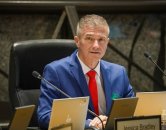Source Feed: National Post
Author: Chris Lambie
Publication Date: June 19, 2025 - 14:34
Lack of working Cyclones frustrates Canada's top sailor: 'The helicopter has been letting us down'
June 19, 2025
Canada’s top sailor is so fed up with the dearth of Cyclone helicopters available to fly off this country’s warships, he’ll replace them with drones if he must.
The fleet of 26 CH-148 helicopters was grounded for most of last month due to spare parts problems. And, as of Thursday, only three of the choppers were available to fly off the country’s warships as the problems persist.
“Am I satisfied? No, not at all,” Vice-Admiral Angus Topshee said in Halifax on Thursday.
Naval officers often say maritime helicopters are the eyes and ears of a warship.
“This is why we’re going all-in on drones right now,” Topshee said. “The Royal Canadian Navy is working to get into contract for an uncrewed aerial vehicle that we can operate. It was meant to supplement the helicopter, but the reality is, if the helicopter can’t be more reliable, then we are going to have to rely even more on other systems.”
As a stopgap, the navy is employing Hammerhead target drones
—
remote-control speedboats it normally uses to mimic small boat attacks
—
to launch sonobuoys ahead of a fleet so ships can detect submarines.
“One of the things a helicopter can do for us is it can drop sonobuoys to help detect submarines. Now we’ve got the ability to do that in other ways,” Topshee said.
“Whenever we’ve been forced to innovate, we will innovate. We will find a way to get the job done. So, the helicopter has been letting us down, but we will find a way to achieve the effect.”
The navy is hoping to have purpose-built aerial drones in operation by next summer, he said, noting the project went out to tender. “We’re in the process of awarding it.”
Topshee — who was in Halifax to celebrate the start of Fleet Week, where the public can tour warships and meet the folks who crew them — doesn’t want to rely on unmanned drones over helicopters.
“A helicopter is a far better platform,” he said. “A helicopter can do everything. So, what we’re going to need to do is take all of the things that we need a helicopter to be able to do and do them individually” in other ways.
To that end, the navy’s experimenting with large drones that can transport equipment between ships, Topshee said. “That’s not a task that we need a well-armed (anti-submarine warfare) helicopter to do,” he said. “If it can be done by a drone very simply without people involved in the process of actually flying it back and forth, that’s ideal for us.”
Topshee is adamant he’s not replacing the Cyclones.
“We’re not,” he said. “We want the Cyclone helicopter to be an effective part of the force.”
The admiral points out that, even when the helicopters are in top shape, they can only operate for 12 hours a day.
“Even if it’s perfectly operational, there’s 12 hours where you don’t have it available,” Topshee said. “Which means we need to be experimenting and ready to operate all of the time.”
Canada has 26 of the ship-borne maritime helicopters, with a final one slated for delivery this year. The $5.8-billion fleet is normally used to provide air support for the navy. Their missions include surface and subsurface surveillance, search and rescue, and anti-submarine warfare.
The Cyclones didn’t fly at all for 27 days in May as the military struggled with spare parts problems with certain components. The Department of National Defence indicated last month that it was working with the military and Sikorsky, which manufactured the helicopters, “to identify potential parts of concern. This includes components of the Cyclone’s landing gear, tail rotor driveshaft flange and auxiliary power unit, as well as engine parts.”
The problems persist, according to Topshee. “It’s a parts issue that’s keeping them grounded.”
Another “messy problem” plaguing the helicopters, he said, is replacing the Cyclones’ ageing datalinks — used to communicate digital information such as radar images to other aircraft, warships and shore bases.
“It is a technology from the 1980s,” Topshee said.
The admiral places the blame for old tech aboard relatively new helicopters, ordered in November 2004, squarely on former prime minister Jean Chretien’s 1993 decision to cancel the contract to buy AgustaWestland’s EH-101 maritime helicopters to replace Canada’s geriatric fleet of Sea Kings, which went out of service in 2018 after flying off navy ships for more than half a century.
“One of the accusations at the time, as we were coming out of the Cold War, was that we had gold-plated the requirement,” Topshee said. “That we were asking for far more than we needed out of a maritime helicopter. The interesting thing is if you were to go back to our initial requirement, it is almost exactly the helicopter we need today because … we’re in a period of great power competition. We need a war-fighting helicopter.”
The military “listened to the complaints,” and watered down the requirements as much as it could, he said. “We specified exactly the systems that we wanted as opposed to saying we need the helicopter to have modern link, modern communications and up-to-date combat systems. We said we needed to have this Link 11 system, which was the state-of-the-art at the time we set that requirement.”
The datalink is “critical” for the Cyclones, he said. “It’s what tells the rest of the force where the helicopter is. It tells the rest of the force everything the helicopter is seeing. So, when it finds a submarine, it uses that link to communicate the position of the submarine to the rest of the force so that we can either target that submarine or avoid the submarine. It also tells us that that’s our friendly helicopter right there so we don’t accidentally shoot it down.”
Canada is negotiating with Sikorsky to get the datalinks updated, Topshee said.
“The timeline is unacceptably long. We’re in negotiations with the company for them to try and deliver it as quickly as possible but right now it’s not quick enough.”
Sikorsky is saying it will take “more than two” years to upgrade datalinks aboard all of the Cyclones, according to Topshee, who wants the choppers upgraded from datalink 11 to datalink 16 and datalink 22.
The Cyclones “can still use the old link … but it doesn’t provide all the functionality that we need,” he said.
“A lot of countries are stopping using it.”
The old datalinks could put Cyclone crews in jeopardy.
“Without the most modern link system, we don’t know exactly where the helicopter is all the time because that system does not provide the same level of positional fidelity that we would expect,” Topshee said.
“The helicopter knows where it is. We just don’t know whether it’s friendly or not all of the time. Can that put them in danger? Yes. In an operational environment where we’re starting to shoot, that could be a problem.”
Our website is the place for the latest breaking news, exclusive scoops, longreads and provocative commentary. Please bookmark nationalpost.com and sign up for our daily newsletter, Posted, here.
Coun. Tim Tierney says Ottawa needs a southern ring road to relieve congestion on the Queensway, instead of a controversial bridge over Kettle Island.
June 26, 2025 - 16:50 | | CBC News - Ottawa
The Public Works and Infrastructure Committee today approved the Transportation Master Plan (TMP) Capital Infrastructure Plan, which will guide the development of the City’s transportation system to 2046.
The TMP is a supporting document of the Official Plan (OP) which projects an increase of more than 400,000 residents in the next 20 years. The TMP identifies transportation policies and infrastructure investments to support that growth. It informs annual budgets, the development charges background study and the City’s long-range financial plans.
The TMP includes the following two...
June 26, 2025 - 16:45 | City of Ottawa - Media Relations / Ville d'Ottawa - Relations avec les médias | City of Ottawa News Releases
While Bill C-5 passed without amendments, a handful of senators attempted to persuade their colleagues to include language about respecting Indigenous rights.
June 26, 2025 - 16:38 | Globalnews Digital | Global News - Canada



Comments
Be the first to comment